by Paula D.
on August 4, 2021 4:20 pm in Events
Last week my friend and I mustered up all of our courage and actually left the peninsula. As we all know, it’s so hard to do during the high season. Mind you, this was a Wednesday, not a weekend (that would be absurd). Meredith and I have both been eager to go to the KUSAMA: COSMIC NATURE exhibit at the New York Botanical Gardens.
I actually saw some of Yayoi Kusama’s work randomly at the Nassau County Museum when I was visiting my sister during the winter. I fell in love with the work. Why? Yayoi Kusama’s art is bold, fun, and bright. I gravitate to the integration into nature.
Here’s a little background on the artist from the NYBG website:
Experience Yayoi Kusama’s profound connection with nature Contemporary Japanese artist Yayoi Kusama is one of the most popular artists in the world, drawing millions to experience her immersive installations. Exclusively at NYBG, Kusama reveals her lifelong fascination with the natural world, beginning with her childhood spent in the greenhouses and fields of her family’s seed nursery. Her artistic concepts of obliteration, infinity, and eternity are inspired by her intimate engagement with the colors, patterns, and life cycles of plants and flowers.
We had so much fun walking around seeing the patterned sculptures intermixed with the breathtaking gardens and grounds. One of my favorite locations is the wooded forest known as Thain Family Forest. Here you’ll find the Hester bridge, built in the 19th century. It’s a foot and bike pass-over that spans over the Bronx River. The bridge is named after Dr. James M. Hester, President of the NY Botanical Gardens from 1980 -1989.

Dancing Pumpkin (2020), viewing from underneath the sculpture was pretty awesome.
The forest area is the coolest KUSAMA installation. It’s called Narcissus Garden, 1966. Large silver globes move and float on water. They reflect the tall grasses and your reflection, which is distorted, as you walk around the pond. According to the artist, the concept forces the viewer to confront one’s ego and vanity.

Narcissus Garden – 1966
I could have spent 8 more hours in the gardens. I’d never been there before and I can’t wait to go back.
It was a no-brainer that we’d get lunch on Arthur Ave! I haven’t been there for so long. My sister was an undergraduate at Fordham so we’d go up almost every Sunday to visit her, go to church and then go out to lunch.
I’m not going to lie, it felt so good to be surrounded by my people. The talking with hands on the streets; the loud fancy cars; the guys with gold crosses and hairy chests; the smell of fried fish and cigars; the sausage and cheese hanging in the salumerias. It felt so warm and right. It felt like home.
We walked into Teitel Brothers (2372 Arthur Ave). Eddie, I’m assuming one of the brothers approached us right away. “Try some of my cheese ladies.” The cheese presented to us is called pre-Madonna, a combination of gouda and parmesan. So good! As he was “helping” us, I saw his mother roll her eyes behind the counter. I’m sure we weren’t the first women Eddie has flirted with using his specialty cheese selection as a lure. But you know what… It worked. We bought the cheese and many other Italian delicacies. His mother’s grimace changed once she opened up the register and took our cash.
Afterward, we had lunch at Enzo’s (2339 Arthur Ave). Meredith and I shared plates of homemade pasta and arugula salad with fresh tomatoes. I had a nice glass of malbec. I must rest and meal in the AC after a lovely day exploring the Bronx.
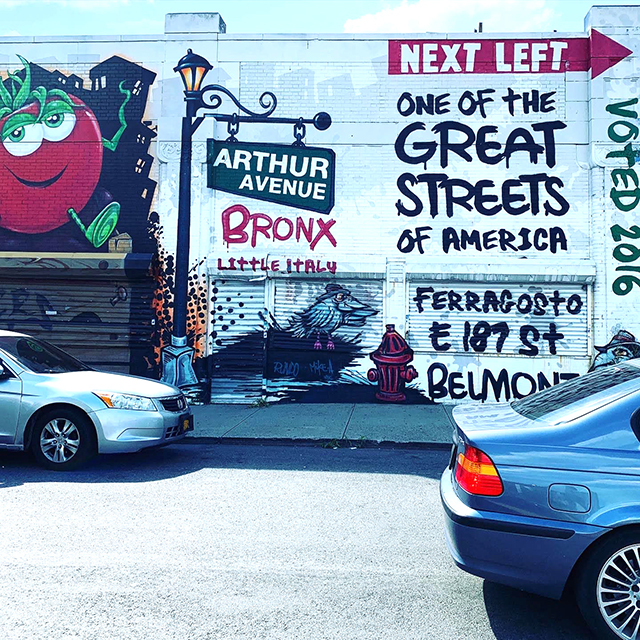
If you love bold art, gardening and Italian food check out the KUSAMA exhibit at the NYBG. It runs through October 31, 2021. On Wednesdays, the outdoor grounds are free for everyone. Then you must go to Arthur Ave. It would be a sin to miss an authentic Italian meal after a long walk in the gardens
My vegetable garden is in full swing! Water is key now that it’s very hot. I’ve been checking on my plants daily, which are across the street from my home in the Beach 91st Street Community Garden. Two plants I want to discuss this week: cilantro and lettuce.
This year’s cilantro crop seeded itself from last year! It just appeared in the spring-like magic. I had to give it the good ol’ taste test. It could’ve been parley. My grandfather would do this in the food stores to figure out what was what. I do it too. Most times these products are labeled now but I like to do it anyway because it reminds me of my grandfather. I’ve been taste-testing in the stores for as long as I can remember. Besides a few side-eyes from shoppers, I’ve never gotten in trouble or kicked out of the supermarket!
The organization of my veg garden this year is a bit of a mess because of where the cilantro re-seeded. I suppose that doesn’t really matter. What’s important is remembering to deadhead cilantro flowers (and any other herb you’re growing). This is done so the energy the plant produces goes to growing more leaves and not to the flowering bud. Doing this will yield an ongoing, larger crop.
Here’s something you may not know, cilantro is the Spanish name for coriander. So they are one and the same. All parts of the plant is edible. When you pinch off the flowers, use that in your chili or to top your tacos! Other great culinary uses for cilantro are in chutneys, salsa, guacamole and to season meats. If your plant does go to seed, save them, dry them and you’ll have coriander spice.
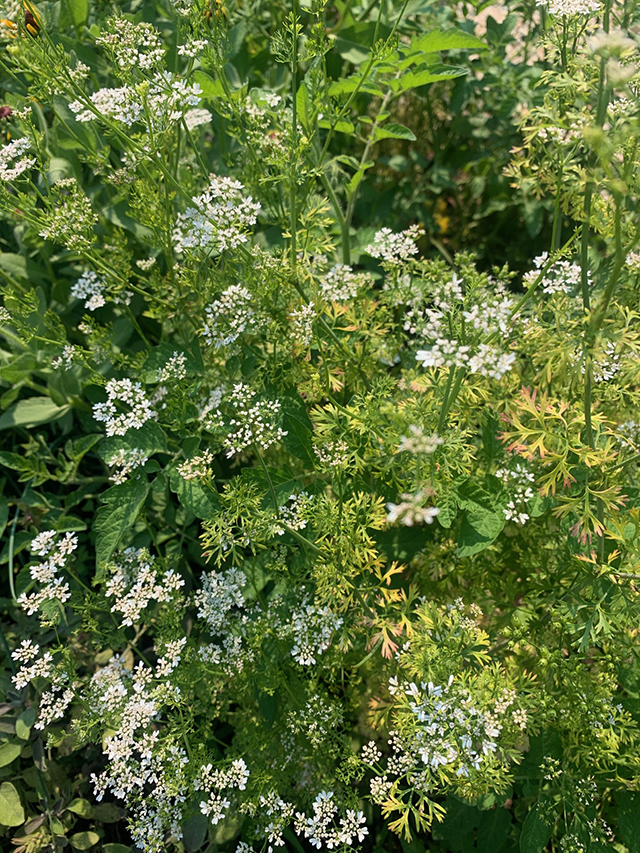
Right now I have more cilantro than I know what to do with it. I’ll have to start taco Tuesdays.
This year is the first time I’ve ever grown lettuce. I love salad so this is exciting for me! It is very easy to start from seed, sowing them in rows in the early spring. Plant shallow as the seeds need some light to germinate. Keep the soil moist during this beginning phase. You can also plant lettuce at the end of the summer as It’s is a cool-weather crop.
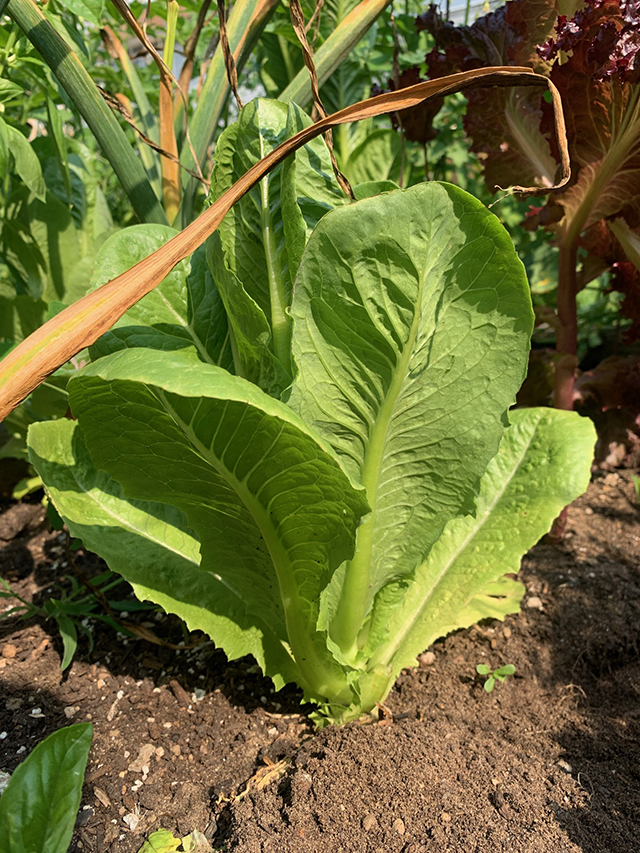
I had to ask a fellow gardener friend about harvesting. There are two main harvest methods. The first – remove leaves as needed from the outside of the plant (the oldest leaves). The inside will continue to grow for later use. The second method is cutting off the whole head when the plant is mature, leaving 1 1 /2 inches of the base. This strategy also allows for the plant to regrow; it will take longer for the lettuce to mature again so there is “wait time” in-between harvests. Through the season the full-cut method will produce 3-4 heads of lettuce.

I have two types of greens in my garden – butter lettuce and red leaf lettuce. Both are thriving. I’m using the cut-as-needed harvest technique. I may experiment with one plant using the second method to see how long it takes to regrow.
Next up will be my long-awaited tomato plant harvest. Every year I can’t wait for this moment. As you may have guessed… tomatoes are my favorite food in the whole world!!
Follow me for the day-to-day on Instagram – @theglorifiedatomato
Strawberry Fields Forever!! John Lennon’s reference in the Beatles song is based on nostalgic childhood memories of him playing in the garden of Strawberry Fields, at the Salvation Army Children’s Home in Liverpool near where he grew up. The Beatles spent 45 hours in the studio over 5 weeks, tracking the song and ended up with three different renditions, finally combining two of them. Is this why the lyric mentions “forever”?
It also may have to do with the fact that strawberry fields actually last forever. You plant one container and over the years it will spread, grow and thrive until you have a field of strawberries… forever. And this happens with practically no maintenance.
June is Strawberry month; July is time for canning. My friend Meredith Urban (@delamer1981) recently visited her grandmother Rita who is a professional(ish) canner. At the age of 90, she is still at it, even with her disability – advanced macular degeneration. What an inspiring woman! It’s a special gift when you’re able to learn cooking and recipes from the eldest in your family. Rita taught her daughter, and her granddaughter Meredith how to cook and bake. This is also how I learned, so the sentiment touches me.
I was given a can of strawberry jelly from Rita. It’s so delicious! I used mine on sourdough bread with butter. I feel the need to share this sweet recipe with you!

Grandma Rita
Grandma Ritas’ Strawberry Jelly
Ingredients:
(makes, 5, 8 ounce jelly jars)
2 cups of mashed strawberries (based on the strawberries being mashed, not whole)
4 cups sugar
1 box Sure Jell (found at most supermarkets) or use natural pectin
Water
Directions: Sterilize the jars and lids in boiling water. Mash the strawberries and mix in 4 cups of sugar, thoroughly. Boil water and add the Sure Jell – follow the directions on the package. Combine the strawberries into the Sure Jell and mix well so it’s not gritty. Use a funnel to fill each 8 ounce jar, leaving some room at the top. Wipe the jars clean, place lids on tightly and leave out for 24 hours. Then refrigerate.
This is “freezer jelly” – lasts up to 5 weeks in the refrigerator.
If you haven’t grown your own, visit Edgemere Farm (385 B 45 St, Queens, NY 11691) for strawberries and other local fruit!
Follow me in the garden day-to-day on instagram – @theglorifiedtomato
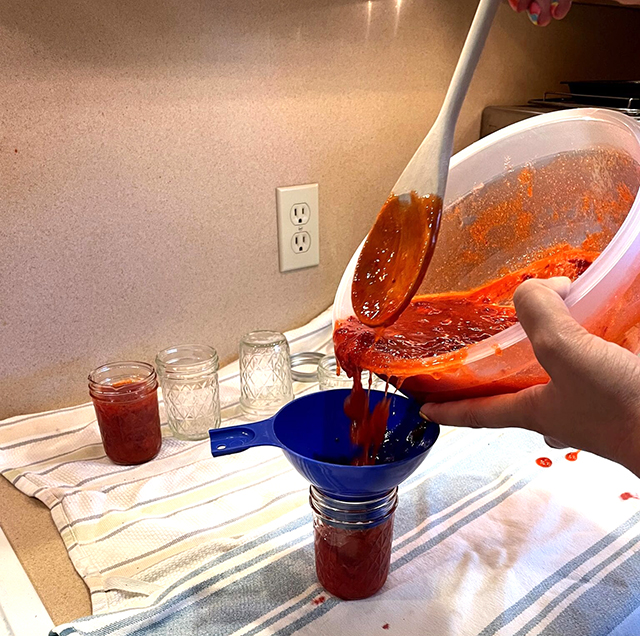
by Paula D.
on July 9, 2021 11:49 am in Gardening
I’ve written before about perhaps my favorite tree – the Serviceberry (Amelanchier arborea). It gives so much. It blooms beautiful, petite white flowers in early spring. It services birds, squirrels (raccoons?), and me with delicious berries in mid-June.
They taste like if strawberries and blueberries had children. The less ripe ones also give you a burst of tartness occasionally, which I like! The color ranges from bright reds to dark burgundy. In late September the foliage turns attractive shades of yellow and rich copper. The tree is salt tolerant which makes it suitable for the peninsula and Broad Channel.
Last year I noticed orange spiky “pods” on the tree where the berries form. But not everywhere, just at random. I thought they were reproductive parts, as it shedded what looked like orange pollen. Being busy, I never got around to investigating it further.
The other morning while I was having coffee and my berry breakfast, I noticed the orange pods again. I decided to google “reproduction, serviceberry tree.” To my surprise, nothing of significance came up. I put in other descriptive search terms and looked at images. Nature always surprises us. There it was. But what I learned was shocking…
Fungus!
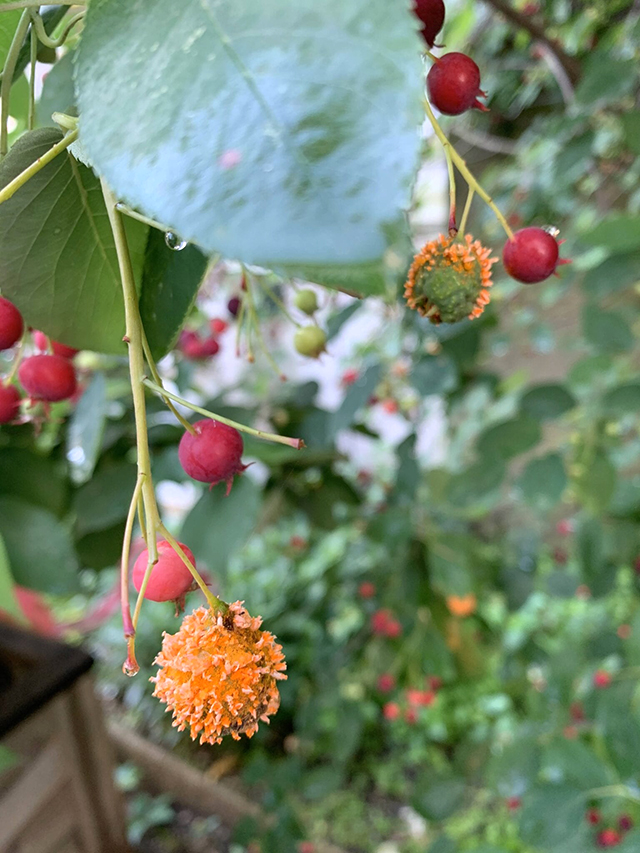
The galls of cedar apple rust, pretty right!
Panic ensued! But as I read further, cedar apple rust fungus is harmless to Serviceberry trees. It only makes infected berries inedible. And the “pods” are called galls.
Some gardeners feel the rust is an aesthetic issue but I think the exact opposite! The fungus is weird and wonderful. It has an organic shape and the bright orange looks pretty against the green leaves and red berries.
I was debating on whether or not I should remove the infected areas. After more research, I decided they should be removed. There’s an apple tree that borders my yard. And this fungus is harmful to apple trees.
My neighbor told me his mother’s apple tree has been living for at least 80 years and has 7 different grafts on it. The tree, since we moved to Rockaway – 7 years now! – has never done well. There’s always been rot and the fruit looks deformed. I believe the fruit tree is also infected with cedar apple rust fungus.
Junipers, which are everywhere in Rockaway, are cedar apple rust hosts in the winter. Then in the spring, during the rainy season, the spores move to other trees. Interestingly, the fungus can not infect the same species of tree in the same year. So it will jump from a Juniper to an apple tree back to a Juniper, as one example.
To control cedar apple rust there are many organic sprays you can buy. Ultimately what combats the fungus is sulfur. Remove infected berries in the spring and rake up and dispose of leaves in the fall putting them in the garbage, not your compost pile.
There are so many things I enjoy about gardening. One of them is this, learning through experience. Just when you thought you knew it all…
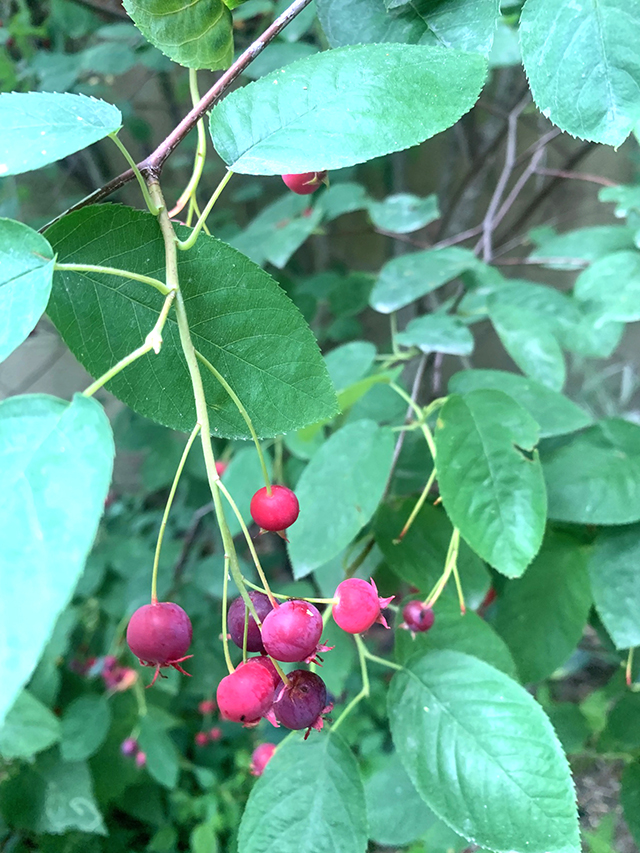
Follow me on instagram for the day-to-day in the garden @theglorifiedtomato

































